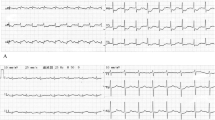Abstract
We studied the experience of a 69-year-old woman with acute decompensated heart failure due to post-infarction ventricular septal rupture. She received mechanical hemodynamic support by Impella 2.5 (Abiomed, Danvers, MA, USA), percutaneous axial-flow left ventricular assist device, which improved intra-cardiac pressure, maintaining end-organ function. She was successfully bridged to the scheduled surgical repair of ventricular septal rupture following the 9-day Impella support and discharged on foot on the 32nd day. Impella might be a useful mechanical circulatory support device as a bridge tool to the scheduled surgical repair of ventricular septal rupture if used with careful daily management to prevent device-related comorbidities.



Similar content being viewed by others
References
Ibanez B, James S, Agewall S, et al. ESC Guidelines for the management of acute myocardial infarction in patients presenting with ST-segment elevation. Eur Heart J. 2018;39:119–77.
O'Gara PT, Kushner FG, Ascheim DD, et al. ACCF/AHA guideline for the management of ST-elevation myocardial infarction. Circulation. 2013;127:e362–425.
Holmes DR, Bates ER, Kleiman NS, et al. Contemporary reperfusion therapy for cardiogenic shock: the GUSTO-I trial experience. J Am Coll Cardiol. 1995;26:668–74.
Arnaoutakis GJ, Zhao Y, George TJ, et al. Surgical repair of ventricular septal defect after myocardial infarction: outcomes from the Society of Thoracic Surgeons National Database. Ann Thorac Surg. 2012;94:436–43 (Discussion 43–4).
Sakaguchi G, Miyata H, Motomura N, et al. Surgical repair of post-infarction ventricular septal defect: findings from a Japanese National Database. Circ J. 2019;83:2229–35.
Dawson AG, Williams SG, Cole D. Does the placement of an Amplatzer septal occluder device confer benefit in patients with a post-infarction ventricular septal defect? Interact Cardiovasc Thorac Surg. 2014;19:1040–7.
Pahuja M, Schrage B, Westermann D, et al. Hemodynamic effects of mechanical circulatory support devices in ventricular septal defect. Circ Heart fail. 2019;12:e005981.
Li H, Zhang S, Yu M, et al. Profile and outcomes of surgical treatment for ventricular septal rupture in patients with shock. Ann Thorac Surg. 2019;108:1127–32.
Patane F, Centofanti P, Zingarelli E, et al. Potential role of the Impella recover left ventricular assist device in the management of postinfarct ventricular septal defect. J Thorac Cardiovasc Surg. 2009;137:1288–9.
La Torre MW, Centofanti P, Attisani M, et al. Posterior ventricular septal defect in presence of cardiogenic shock: early implantation of the impella recover LP 5.0 as a bridge to surgery. Tex Heart Instit J. 2011;38:42–9.
Ancona MB, Regazzoli D, Mangieri A, et al. Post-infarct ventricular septal rupture: early Impella implantation to delay surgery and reduce surgical risk. Cardiovasc Interv and Ther. 2017;32:381–5.
Seyfarth M, Sibbing D, Bauer I, et al. A randomized clinical trial to evaluate the safety and efficacy of a percutaneous left ventricular assist device versus intra-aortic balloon pumping for treatment of cardiogenic shock caused by myocardial infarction. J Am Coll Cardiol. 2008;52:1584–8.
Nakamura M, Imamura T, Ueno H, et al. Current indication and practical management of percutaneous left ventricular assist device support therapy in Japan. J Cardiol. 2019. https://doi.org/10.1016/j.jjcc.2019.12.003.
Patel N, Sharma A, Dalia T, et al. Vascular complications associated with percutaneous left ventricular assist device placement: A 10-year US perspective. Catheter Cardiovasc Interv. 2020;75:228–32.
Sibbald M, Dzavik V. Severe hemolysis associated with use of the Impella LP 2.5 mechanical assist device. Catheter Cardiovasc Interv. 2012;80:840–4.
Badiye AP, Hernandez GA, Novoa I, et al. Incidence of hemolysis in patients with cardiogenic shock treated with Impella percutaneous left ventricular assist device. ASAIO J. 2016;62:11–4.
Cardozo S, Ahmed T, Belgrave K. Impella induced massive hemolysis: reemphasizing echocardiographic guidance for correct placement. Case Rep Cardiol. 2015;2015:464135.
Nakao Y, Aono J, Tasaka T, et al. Impella 5.0 mechanical assist device catheter-induced severe hemolysis due to giant swinging motion- new concern in Impella usage. Circ J. 2019;83:2080.
Author information
Authors and Affiliations
Corresponding author
Ethics declarations
Conflict of interest
There is no conflict of interest related to this manuscript.
Additional information
Publisher's Note
Springer Nature remains neutral with regard to jurisdictional claims in published maps and institutional affiliations.
Rights and permissions
About this article
Cite this article
Nakamura, M., Imamura, T., Fukui, T. et al. Impella support as a bridge to scheduled surgical repair of ventricular septal rupture. J Artif Organs 23, 278–282 (2020). https://doi.org/10.1007/s10047-020-01163-2
Received:
Accepted:
Published:
Issue Date:
DOI: https://doi.org/10.1007/s10047-020-01163-2




